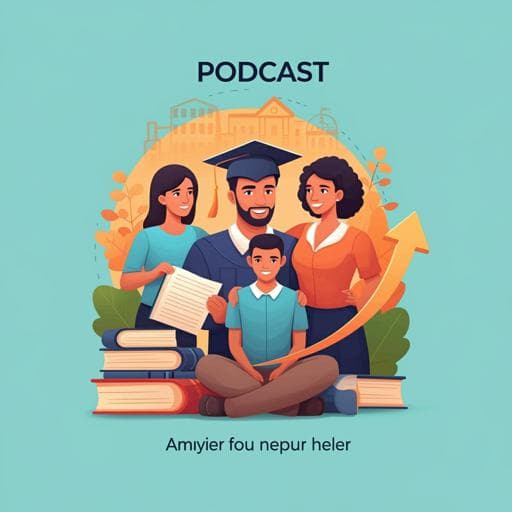
Education
Cultural capital as a predictor of school success: evidence and gender differences in Chinese middle schools
H. Jin, S. Jiao, et al.
This fascinating study by Hui Jin, Shi Jiao, Xu Ma, and Yunan Xia delves into how family cultural capital influences the academic performance of Chinese middle school students, highlighting gender-specific impacts. Discover the dynamic interplay between parental education and student success, and learn how tailored educational strategies could benefit vulnerable groups.
~3 min • Beginner • English
Introduction
Ensuring quality and equitable education remains a challenge despite gains in enrollment. Cultural capital—conceived by Bourdieu as a scarce resource that can be transmitted and converted into educational advantage—is a key determinant of educational equity and student achievement. Prior work often emphasizes institutionalised (e.g., parental education) and objectified (e.g., books) cultural capital, with less attention to embodied cultural capital (e.g., highbrow cultural participation). Evidence on how different levels of cultural capital influence academic performance, particularly among younger students and across genders, remains limited. This study aims to clarify the mechanisms and magnitudes by which institutionalised, objectified, and embodied cultural capital affect middle school students’ academic achievement and to examine gender differences. Research questions and hypotheses: RQ1: What is the effect of cultural capital on students' academic achievement in middle schools? H1: The institutionalised state has a positive impact on academic attainment. H2: The objectified state has a significant impact on academic attainment. H3: The embodied state has a significant impact on academic attainment. RQ2: What is the effect of gender-differentiated family cultural capital on students' academic achievement? H4: For male students, family cultural capital has a significant positive impact on academic attainment. H5: Female students' educational attainment is significantly influenced by family cultural capital.
Literature Review
The study is grounded in Bourdieu’s cultural capital theory, which differentiates cultural capital into institutionalised (e.g., formal credentials and parental education), objectified (cultural goods like books and artworks), and embodied states (lasting dispositions such as participation in highbrow cultural activities). Cultural capital is reproduced intergenerationally and contributes to educational advantages. DiMaggio complements this by highlighting cultural mobility, suggesting that active engagement in elite culture can facilitate upward social movement, especially for lower-status students. Empirical literature generally finds positive associations between cultural capital and academic performance, with parental education and home literacy environments predicting achievement. However, there is no consensus on a core measurement standard for cultural capital, and the mechanisms through which different forms influence performance remain under-specified. Prior studies frequently focus on higher education or regional comparisons, leaving gaps concerning embodied cultural capital and gender differences among middle school students. The present study seeks to fill these gaps by simultaneously assessing all three forms of cultural capital and exploring gender-specific effects.
Methodology
Design and sample: A cross-sectional survey was conducted in four middle schools in Beijing selected to be similar in socioeconomic context, teaching quality, scale, and influence, and representative of average-ranked schools. Of 1100 questionnaires distributed, 1036 valid responses were collected from students in grades 7–9 (491 boys, 47.4%; 545 girls, 52.6%). A paper questionnaire was administered in-class within 15 minutes, with assurances of confidentiality. Measures: Dependent variables were standardized subject scores (0–100) in Chinese, English, and Mathematics, and their sum (overall score, 0–300). Independent variables operationalized family cultural capital at three levels: (a) institutionalised—father’s and mother’s educational attainment (1=elementary or below to 7=doctorate); (b) objectified—household book collection (1=0–10 to 7=301+ volumes) and household English book collection (1–7 scale); (c) embodied—individual talent count (1–7), frequency of visiting galleries/museums, science museums, concerts/plays, and frequency of in-town, out-of-town, and overseas travel (all on 1–7 frequency scales). Controls included grade (7–9), gender, number of children in household (1–4+), household income (1=very low to 5=very high), and area (A–D). Analysis: First, associations between ordinal predictors and interval outcomes were examined using the correlation ratio (Eta squared, 0–1), complemented by one-way ANOVA F-tests to assess significance. Variables with very weak associations (e.g., negligible Eta squared) were excluded in some regressions. Primary inference used multiple linear regression models for each outcome (Chinese, English, Math, Overall), estimating the effects of cultural capital variables net of controls. Separate regressions were run for the full sample and stratified by gender to assess differential effects.
Key Findings
Correlation and ANOVA indicated significant associations between most cultural capital indicators and academic outcomes (Chinese, English, Math, Overall), with exceptions including weak links for individual talent (to English, Math, Overall), out-of-town travel to Chinese, and overseas travel to Chinese and Math. Full-sample regressions: Institutionalised cultural capital—Father’s education positively predicted English (β=0.969, p<0.05) and Overall (β=2.385, p<0.10); no significant effects on Chinese or Math. Mother’s education positively predicted Chinese (β=0.940, p<0.01) and Overall (β=2.868, p<0.05); not significant for English or Math. Objectified cultural capital—Household book collection positively predicted all outcomes: Chinese (β=0.856, p<0.01), English (β=1.217, p<0.01), Math (β=1.172, p<0.01), Overall (β=2.701, p<0.01). Household English book collection positively predicted English (β=0.638, p<0.05). Embodied cultural capital—Attending concerts/plays positively predicted Chinese (β=0.520, p<0.10). Overseas travel negatively predicted Overall (β=−2.049, p<0.10). Gender-stratified regressions: Institutionalised—For boys, father’s education predicted English (β=1.459, p<0.05) and Overall (β=4.301, p<0.05). For girls, mother’s education predicted Chinese (β=1.417, p<0.01), English (β=1.843, p<0.01), Math (β=2.197, p<0.01), and Overall (β=5.351, p<0.01). Objectified—Household book collection was positively associated with Chinese, English, Math, and Overall for both boys (Chinese β=1.028, p<0.01; English β=1.751, p<0.01; Math β=1.208, p<0.05; Overall β=2.930, p<0.05) and girls (Chinese β=0.707, p<0.01; English β=0.854, p<0.01; Math β=1.212, p<0.01; Overall β=2.670, p<0.01). Household English book collection predicted boys’ English (β=0.748, p<0.10). Embodied—For girls, attending science museums predicted Math (β=2.618, p<0.01) and Overall (β=4.285, p<0.01). For boys, attending concerts/plays predicted Chinese (β=0.863, p<0.10), while overseas travel negatively predicted Overall (β=−2.049, p<0.10). Overall, institutionalised and objectified cultural capital showed consistent positive associations with achievement, while embodied cultural capital had mixed effects, and notable gender differences were observed.
Discussion
Findings address RQ1 by demonstrating that institutionalised (parental education) and objectified (home book resources) cultural capital significantly and positively influence middle school students’ achievement, whereas embodied cultural capital exhibits both beneficial (e.g., concert attendance) and detrimental (e.g., overseas travel) associations, depending on the outcome. The patterns align with cultural reproduction theory, indicating intergenerational transmission of advantage via parental education and resource-rich home environments. Mechanistically, higher-educated fathers may support English learning given the strong English requirements in higher education, while higher-educated mothers may contribute more to Chinese language development through cultural and literacy socialization. Objectified resources like general and English-language book collections facilitate subject-specific learning and overall academic performance. For RQ2, gender-stratified analyses show differentiated pathways: fathers’ education more strongly relates to boys’ English and overall scores, whereas mothers’ education robustly predicts girls’ performance across all subjects. Embodied experiences also differ by gender: science museum visits benefit girls’ math and overall performance, concert/theatre attendance supports boys’ Chinese, and overseas travel is negatively related to boys’ overall scores. These results underscore the nuanced, gendered mechanisms by which cultural capital shapes achievement and suggest that policies and family practices should be tailored to leverage beneficial forms of cultural capital while being mindful of experiences that may not translate into academic gains.
Conclusion
Three categories of cultural capital influence middle school academic achievement in distinct ways. Institutionalised and objectified cultural capital exert strong positive effects, while embodied cultural capital has mixed (positive and negative) effects. The impact of cultural capital varies by gender: fathers’ education is more consequential for boys’ English and overall scores, whereas mothers’ education substantially benefits girls across Chinese, English, Math, and overall achievement. Contributions include: providing empirical evidence from Chinese middle schools; extending cultural capital theory into family education contexts; and reaffirming the contemporary relevance of cultural capital for educational equity. Practical implications include fostering coordinated education among schools, families, and society; encouraging active parental involvement; supporting disadvantaged students lacking cultural capital; enriching home literacy (including English books); promoting beneficial cultural activities (concerts, museums) tailored to student needs; and optimizing diversified educational evaluation and student-centered teaching.
Limitations
Generalizability is limited by the sample of four Beijing middle schools; larger, more diverse samples across China are needed. The study focuses on observed associations and does not fully unpack underlying mechanisms; future work should combine surveys and interviews to probe causal pathways. Outcomes were limited to Chinese, English, and Math; broader subject coverage is warranted. Future research should consider urban–rural differences, social capital effects, variations in teaching and learning conditions across regions and schools, changes in cultural capital in the digital era, and the impact of artificial intelligence on cultural capital.
Related Publications
Explore these studies to deepen your understanding of the subject.







